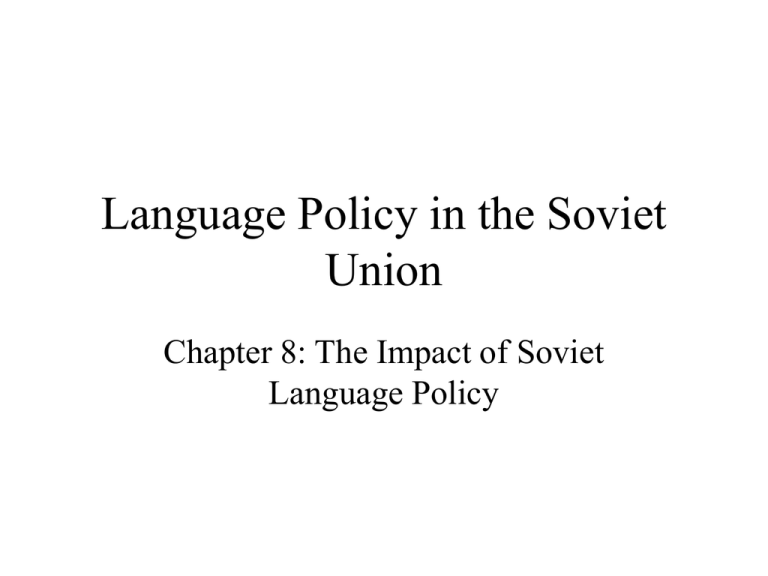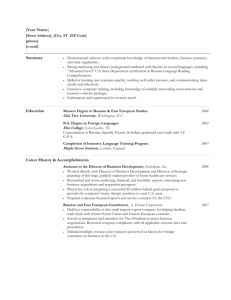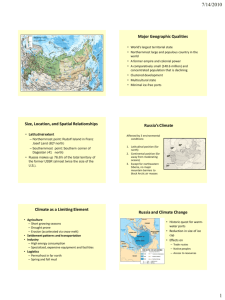Language Policy in the Soviet Union
advertisement

Language Policy in the Soviet Union Chapter 8: The Impact of Soviet Language Policy The Impact of Soviet language Policy • Goals shifted over time, and official goals and actual policies were often in conflict – usually this meant that official goals were supportive of diversity, whereas policies weren’t • Literacy campaign and spread of Russian were both very successful – Urbanization, industrialization and demographic changes in contributed to spread of Russian Language shift • What is language shift and what do we know about it and contributing factors in the former USSR? 1. Language shift • Initially native-language instruction was begun in many languages, even Ukrainian and Belarusan • Lenin’s policy guaranteed the right to use a mother tongue • Early language planners made significant investments in developing indigenous languages, and fieldwork continued throughout Soviet era 1. Language shift, cont’d. • Russification policies began prior to WWII and became more overt & intense after the war – For example, early use of Latin alphabet signalled distancing from tsarist Russia, but switch to Cyrillic in 1939s applied force aligned with Russification – 1938 decree made study of Russian obligatory 1. Language shift, cont’d. • Reforms of 1958-9 made native-language instruction optional, not obligatory, and opened the door for monolingual Russian instruction for all children • By late Soviet era, the majority of Soviet citizens were bilingualism in Russian, many people had given up native languages, but a few groups held on to their heritage languages 1. Language shift, cont’d. • USSR supported unidirectional bilingualism: nonRussians learned Russian, but ethnic Russians remained monolingual • Between 1970-79 Russian fluency increased for all ethnic groups (except Estonian), and between 1979-89 it increased for all except Belarusan, Karakalpak, Komi, Latvian, Lithuanian, Mari, Tajik, Udmurt, and Uzbek 1. Language shift, cont’d. • By the 1970s, Russian had become the primary -- and in many instances the sole -language of education • But did knowledge of Russian increase because of schooling, or for other reasons: role of Russian in society, politics, government administration, prestige? 1. Language shift, cont’d. • In 1994, it was estimated that 63 languages in Russia were endangered, including ALL of the languages of the North that had been targeted for development • Overall figures for languages of the North shows that for every thousand people, Russian is used by 601 in the home, 758 in school, and 732 at work • Massive, probably irreversible language shift Shifting demographics • What demographic patterns do we see in the former USSR and how did they affect the use of languages? 2. Shifting demographics • The extent to which any individual group acquired Russian, and maintained or relinquished its heritage language, is directly correlated with population density and size, and with the ratio of Russians to non-Russians living in a given area • Demographics have been influenced by differences in birthrate, family size, migrations, deportations, and urbanization 2. Shifting demographics, cont’d. • Since 1940 only Tajik and Uzbek birthrates rose, while at the same time the death rate, which went down everywhere, went down more, by a half, in Central Asia -- this means that there was a decline in population growth in Baltic, Slavic, Georgian, and Armenian republics (1980 growth rate is 10% or less, except in Armenia 16.7%), but an increase in Central Asia and Azerbaijan (where growth rate is over 20%, except in Azerbaijan 18.2% and Kazakhstan 17%) 2. Shifting demographics, cont’d. • In Central Asia, only Kazakhstan had a slight decline in growth rate (due to large number of Russians there), but still the overall rate is high • Central Asia and Azerbaijan (Turkic parts of USSR) grew much faster than all others • Slavic and Baltic republics also had highest death rates in late Soviet era 2. Shifting demographics, cont’d. • Differences in demographics gave strength to local populations, their perception of their own power was certainly a determining factor in the creation of language laws in 1989, 1990 and thereafter 2. Shifting demographics, cont’d. • Stalinist deportations added to ethnic tensions in late Soviet era – E.g. 1941 1M Volga germans deported to Central Asia (mostly Kazakhstan) • Many Russians emigrated to other republics -- they lived primarily in cities where they were often dominant, disproportionately well educated, and placed in more bureaucratic and educational positions -- their power and visibility contributed to anti-Russian sentiments – E.g. In Estonia & Latvia Russians made up nearly half the population by 1989 2. Shifting demographics, cont’d. • In Uzbekistan 1959 Uzbeks outnumbered Russians 4.5 to 1, but in 1989 8.5 to 1; in Kazakhstan and Kirgizstan there were proportionally more Russians, so these republics were more tolerant of Russian toward the end of the USSR • Often a large population of Russians caused panic for a local ethnic group 2. Shifting demographics, cont’d. • The presence of Russians was more influential in areas that were previously sparsely populated with small ethnic groups -- they suddenly found themselves vastly outnumbered by Russians, as in the case of the Selkups 2. Shifting demographics, cont’d. • Urbanization proceeded as a by-product of industrialization, and this happened rapidly in early Soviet era • Russian was the preferred language in all professional spheres • Russians settled in cities, and native peoples moved to cities too and came in contact with Russians 2. Shifting demographics, cont’d. • By end of Soviet era, 25M Russians lived in non-Russian republics, and constituted 18% of population there • Russians were concentrated in cities, and particularly in capitals • The language of state business was Russian, and in the USSR all affairs were state business 2. Shifting demographics, cont’d. • Other groups from all over USSR immigrated to cities, and Russian was the language of inter-ethnic communication • Functional bilingualism became a necessity for local people in cities The new nativization movements • Compare nativization movements in 1920s with those in 1980s-90s. How did they differ? What were the outcomes? 3. The new nativization movements • Early nativization campaign (1920s) was top-down, characteristic of Soviet era • 1980s & 1990s -- new nativization (though it was not called by this name) -independent movements to support languages & cultures of non-Russians -these are bottom-up Language laws • When, why and where were language laws enacted in the former USSR? 3.1 Language laws • 1989-90 Republic language laws were a reaction to Soviet language policies, and began in late Gorbachev era – all but RSFSR (language law later, in 1991), Armenia, Azerbaijan, Georgia -- but language legislation was in 1978 constitutions of Caucasian republics • 1990 All-Union Language Law 3.1 Language laws, cont’d. • (Most) Republic language laws: – Identify titular language as official – Require knowledge of both titular language and Russian for state employees – Specify a timeframe (3-8 years -- unrealistic!) for transition from Russian to titular language – Reflect widespread public belief in need to counteract Soviet Russification 3.1 Language laws, cont’d. • 1990 All-Union Language Law – Futile attempt to regain control of language legislation in the Republics – Declared Russian the official language of the USSR – Declared right of republics to establish their languages as state languages (which they had already done) 3.1 Language laws, cont’d. • RSFSR was last republic to act on language legislation, in Oct 1991 (re-ratified in 1993) – Declared Russian official – Left status of other languages to republics (21 new republics established in Russian Federation) -- most grant official status to both titular language and Russian • Daghestan declares all written languages official 3.1 Language laws, cont’d. • Official languages of republics in Russian Federation are: Adyge, Altai, Balkar, Bashkir, Buriat, Chuvash, Eryza, Ingush, KabardianCircassian, Kalmyk, Karachay, Khakass, KomiZyrian, High & Low Mari, Moksha, Osetin, Russian, Tatar, Tuvin, Udmurt, Yakut, plus in Daghestan: Avar, Dargwa, Kumyk, Lak, Lezgi, Nogai, Tabassaran; also: Chechen, Karelian, Komi-Permyak • Current policies are implemented at local level 3.2 Local-level reactions • 1980s resurgence of interest in language instructions in schools, but by then it was necessary to teach ”native” languages as if they were foreign languages – Grass-roots movements among Dolgans, Itelmen, Khanty-Mansi, Ngasanan, Saami, Selkups, Yupiks results in 1990 Association of Northern Minorities 3.2 Local-level reactions, cont’d. • Grass-roots endeavors face lack of resources, economic prestige of Russian, cutbacks in classroom hours for indigenous languages -prognosis is not good • Sometimes local peoples reject indigenous instruction as an unneccesary burden • Soviet policy shaped a need for knowledge of Russian, and that persists, creating a society that is effectively monolingual Conclusion • Soviet era showed dramatic increase of use in Russian, and language shift (loss of indigenous languages) • Russian became essential for any member of society to participate in government, receive education, and work • The spread of Russian fostered ill will that was a critical factor in the downfall of the USSR Conclusion, cont’d. • It was ultimately impossible to create a Soviet people without nationalistic or ethnic identities • By the time of the breakup of the USSR, all languages and cultures felt endangered • Heightened awareness of importance of language in preservation and continuation of culture • Lack of financial resources continues to hamper efforts at language development






